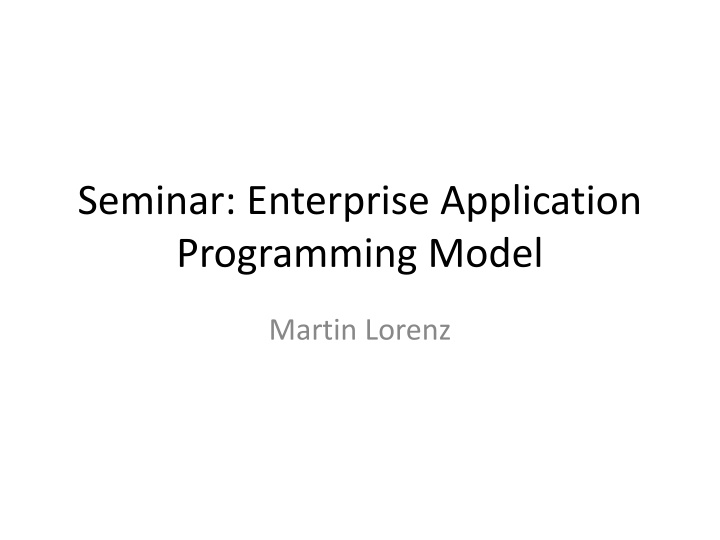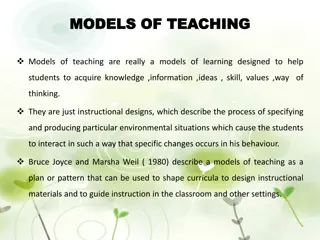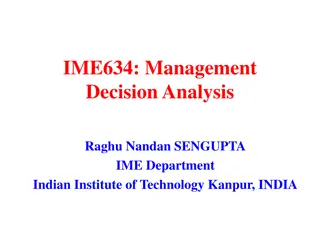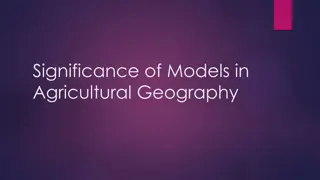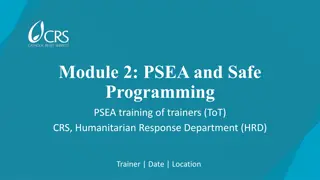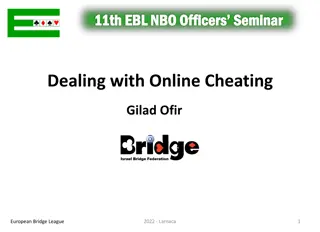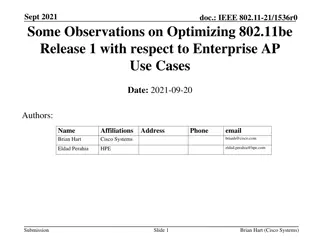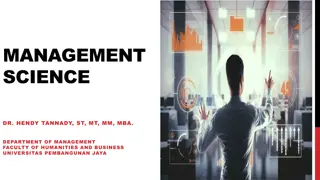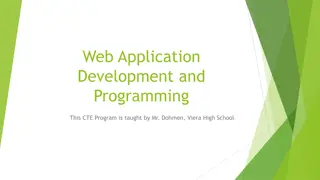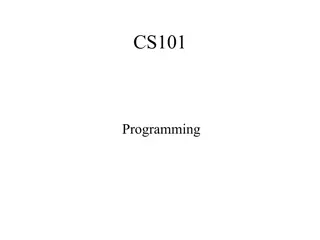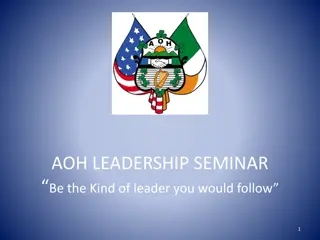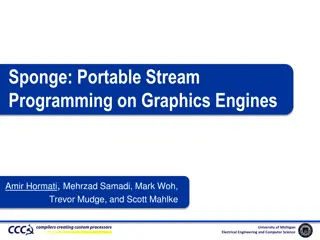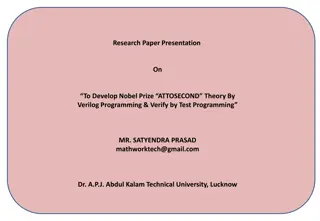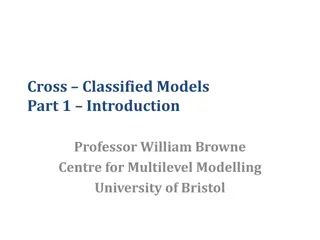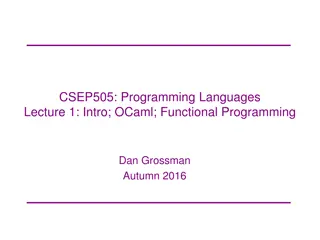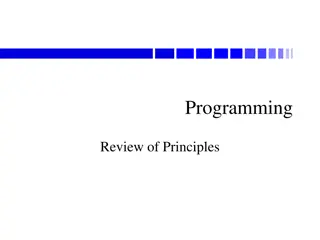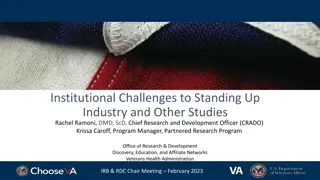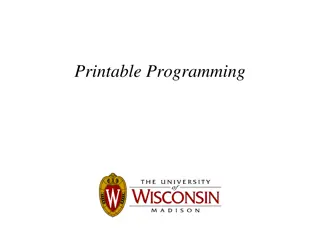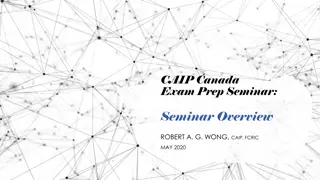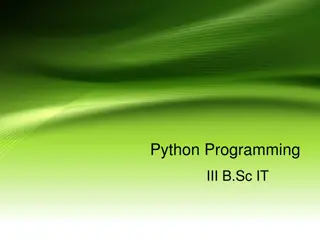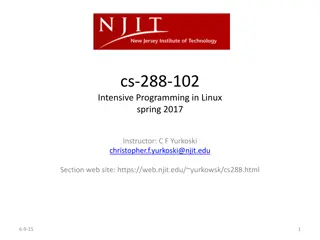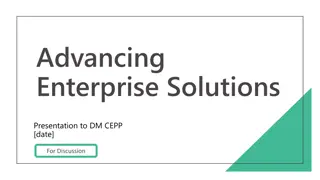Seminar on Enterprise Application Programming Models
This seminar focuses on enterprise application programming models, covering organizational aspects, project goals, content, selection process for seminar topics, and understanding enterprise software. Organized by Prof. Hasso Plattner, the seminar aims to provide an in-depth exploration of project themes and enhance presentation skills, research capabilities, and project experience.
Download Presentation

Please find below an Image/Link to download the presentation.
The content on the website is provided AS IS for your information and personal use only. It may not be sold, licensed, or shared on other websites without obtaining consent from the author.If you encounter any issues during the download, it is possible that the publisher has removed the file from their server.
You are allowed to download the files provided on this website for personal or commercial use, subject to the condition that they are used lawfully. All files are the property of their respective owners.
The content on the website is provided AS IS for your information and personal use only. It may not be sold, licensed, or shared on other websites without obtaining consent from the author.
E N D
Presentation Transcript
Seminar: Enterprise Application Programming Model Martin Lorenz
Organisatorisches Rahmenbedingungen Verantwortlich: Prof. Hasso Plattner Tutoren: Martin Lorenz, Franziska H ger, Arian Treffer, Stephan M ller Ort: SNB-E 9/10, Hasso Plattner High-Tech Park Zeit: Dienstag, 11h00-12h30 4 Semesterwochenstunden 6 benotete Leistungspunkte Einschreibefrist 31. Oktober 2012 2
Organisatorisches Ziele des Projektseminars Gesamt berblick ber das Themengebiet erlangen und das eigene Projektthema einordnen k nnen eigenst ndiges Einarbeiten in eine Themenstellung spezielles Wissen im Projektthema gewinnen Projekterfahrung sammeln Pr sentationstechniken aneignen Grundlagen des wissenschaftlichen Arbeitens erlernen 3
Organisatorisches Inhalte des Projektseminars Vorstellung des Themengebietes Einf hrung in wissenschaftliches Arbeiten Pr sentationen der Projektgruppen zu projektrelevanten Themen Leistungserfassung Projektergebnisse & Ausarbeitung 60% Zwischen- und Endpr sentation 20% Wissenschaftliches Arbeiten und pers nliches Engagement 20% Besonderheit: Keine Pr senzveranstaltungen. Ca. 60min Treffen pro Woche mit Betreuer. 4
Organisatorisches Auswahlprozess f r die Seminarthemen 1. F r Projektseminarthemen bewerben * Priorit tenliste abgeben * Im Seminar oder per Mail an Martin * * Inhalt: drei priorisierte W nsche Deadline: 22. Oktober 2012 2. Zuordnung von Projektteams zu Projektseminarthemen (23.10.2012) 5
What is Enterprise Software? Enterprise applications are about the display, manipulation, and storage of large amounts of often complex data and the support and automation of business processes with that data. Martin Fowler Patterns of Enterprise Application Architecture Patterns (2002)
The Essence Large amounts of complex data derived from real world entities Automation of business processes based on data Business intelligence and decision support based on data
The essential Questions How do we represent the data? How do we interact with the data? Class PurchaseOrderProcess { ... public void releaseAllPurchaseOrders() { List<PurchaseOrder> orders = getOpenP_Orders(); for(Order o : orders) { o.setStatus(Order.RELEASED); saveP_Order(order); } APP-Server Database } ... }
How do we represent the Data? Customer Order Receipt Product Raw Material
Real World Entities Order Attributes: Date Due Date Customer Line Items Signature etc.
Programming Constructs Example: domain model for oo programming environment Line Item - Product - Amount - ... 1 1 Receipt Order - Date - ... 1 Objects capture the relevant information of real world entities and give them a logical structure. - Date - Due Date - Status - ... * 1 1 Customer - Name - Address - ... * * Product - Name - Price - ... Raw Material * - Name - Inventorylevel - ... *
Persistent Storage Example: Relational Database Management Systems (RDBMS) normalization receipt product order lineitem address customer - id - date - fk_order_id - id - date - due_date - status - id - fk_product_id - fk_cutomer_id - amount - id - name - price - id - name - fk_address - id - city - zipcode - street raw material - id - name - inventorylevel
The Mapping Problem Real World Programming Environment Database
How do we interact with the Data? There are two interaction models Online Transaction Processing (OLTP) Entity management Online Analytical Processing (OLAP) Analytics Single Record Processing vs. Set Operations
Challenges for Enterprise Software Massive code base Handle a lot of data Access data concurrently Conceptual dissonances within data Customer structure for dept. 1 <> customer structure for dept. 2 Complex business illogic Data schema evolution triggered from inside (e.g., change DB) outside (entity evolution, new business functions)
Seminar Topics 1. SQL Pattern Search 2. SQL4JAVA 3. Object Inheritence in RDBMS 4. Visualization of Execution Traces 5. Immediate Feedback for Programmers 6. Application Characteristics 7. Materialized Aggregates Maintenance
SQL Pattern Search SOURCE CODE: LOOP AT TOTAL. ... SELECT SINGLE FOR UPDATE * FROM <table> WHERE ... ... ENDLOOP. SQL: SELECT * FROM AST as AST1, AST as AST2, INCLUDE, SOURCE WHERE AST1.vertex_value = SELECT_STMT AND AST2.vertex_value = LOOP_COMP AND AST1.origin = AST2.origin AND AST1.pre_order <= AST2.pre_order AND AST1.post_order >= AST2.post_order AND INCLUDE.hash = AST1.hash AND SOURCE.origin = INC.hash;
SQL4JAVA public static Double calculateAmount() { Double amount = 0; Connection conn = PersistencyManager.getConnection(); try { Statement stmt = conn.createStatement(); ResultSet result = stmt.executeQuery("SELECT SUM(amount) as amount FROM orders"); while(result.next()) { amount = result.getDouble( amount ); } stmt.close(); conn.close(); } catch(SQLException e) { e.printStackTrace(); } return amount; } public static Double calculateAmount() { Double amount = SELECT SUM(amount) FROM orders; return amount; }
Object Inheritance in an In-Memory Database Vehicle Motorcycle Car Bicycle Bus Truck SUV Programming Environment ??? ??? ??? Database
Visualization of Execution Trace Data testCanMoveNavalBase (20 incovations) + name="Bonin" water=false data=GameData@1 + name="4 Sea Zone" water=true data=GameData@1 + testCanLandAirfield (20 incovations) + name="Bonin" water="false" data=GameData@1
Immediate Feedback for Programmers Introduction Do you know that? What if you could see how your code changes the outcome immediatly? Check out Bret Victors approach: http://vimeo.com/36579366
Immediate Feedback for Programmers Research Questions How could enterprise application development benefit from immediate feedback? Which programming tasks benefit most from immediate feedback (e.g. debugging, programming, testing)? How can immediate feedback be implemented and integrated into common IDEs?
Application Characteristics Motivation: Database should know how the application behaves to tune data model and materialization strategies for optimal performance Research Questions: How can app characteristics be extracted from an application workload (SQL traces, dictionary access)? Evaluate different languages to describe app characteristics in a way consumable for a caching/materialization manager within the database
Materialized Aggregates Maintenance Data updates need to be propagated to corresponding materialized aggregates (transparent for application) Research Questions Evaluate existing maintenance strategies within the context of an IMDB (Hyrise, HANA) Focus on correlation with the Merge process Discuss garbage collection strategies for aggregates
